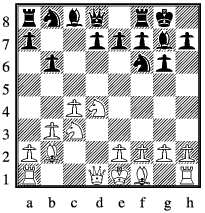
November 2013

|
| RR v Alex Cartlidge after 7 ... 0-0 |
8 e4 d6, 9 Bd3 Bb7, 10 0-0 Nbd7, 11 Qe2 supporting the e-pawn, sideways support of the bishop and freeing d1 for a rook. Must be careful that the queen doesn't become overloaded. Meanwhile my knight on d4 is very happy as dislodging it with e5 would block blacks dark squared bishop and leave his d-pawn backward on a half open file. For the next few moves we were both (anyway I assume Alex was too) spending time on calculating the outcomes of various exchanges in the centere to se whether I would drop a piece.
11 ... Nc5 This knight too will be hard to dislodge, for b4 leaves the c4 pawn exposed, though at least initially it would be well defended.
12 Rad1 Nh5, 13 Qe3 Nf4, 14 Bb1 Another real timewasting decision.
Do I want 14 Qxf4 Bxd4?
Can I afford 14 Bb1 Bh6? Clearly RR feels that the answer to the second question is yes.
14 ... Nfe6 draw offered.
And declined:
15 Nde2 Qe8, 16 f4 A fairly traditional attacking move, which hopefully will move the focus of the game away from the centre and towards black's king. Memo to self. keep an eye on d4. don't want blacks bishop appearing there!
16 ... Nc7, 17 f5 h6 and another draw offer. Diagram right.
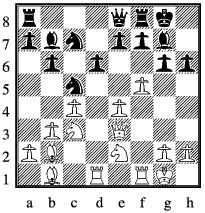
|
| RR v Alex Cartlidge after 17 ... h6= |
19 Rxd5 f5
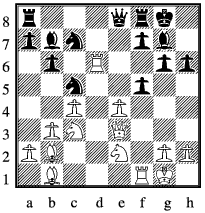
|
| RR v Alex Cartlidge after 19 ... f5 |
21 Bxg7 Nxd6 saves the knight and helps himself to a rook.
22 Qxh6 not Bxf8 which simply confirms the material deficit. It is all an act of faith that the attack is worth the rook.
22 ... f6, 23 Nf4 Qe7 which helps the attack more than the defence. there are useful knight moves at blacks disposal such as Nf7 and Nxe4.
24 Qh8+ Kf7, 25 Qh7 Ke8, 26 Nxg6 Qf7 and a third draw offer, which went the same way as the first two.
27 Nxf8 Ncxe4, 28 Re1 Rd1 discouraging Kd8 is obviously better in the cooler light of analysis, but its worth pointing out that we are already both down to under well 5 minutes, and despite the increments, not loking for big thoughts. Indeed i would have liked to have been able to play Qg6 to force the queens off to reach what I assume is an advantageous endgame. Unfortunately after an exchange on g6, black plays Kf7 and I lose a piece.
28 ... Kd8, 29 Bxe4 Bxe4, 30 Qh6 RR gets ready for his knight to suffer a second attack and also stops any possible problems with f4. But he has overlooked the superior Bxf6+, which black cannot take.
30 ... Kc7, 31 Nh7 Totally the wrong plan. The knight is comfortable there, so Rd1 much better. instead the time scramble is not good to RR
31 ... Rg8, 32 Bxf6 Rxg2+, 33 Kf1 Rg6, 34 Qh4 Bg2+, 35 Ke2 Qe6+ and I've lost the last few moves leading to RR being mated, but its something like
36 Kd3 (d1 must be better) Be4+, 37 Kc3 Rg2
38 Bd8+ Kc6, 39 Rc1 Qe5+, 40 Kb4 Qa5#
Do I regret declining the draw offers? No, but I do rue not completing my attack properly. Fritz says of the offers that they are getting progressively worse, scoring my edges on the successive occasions as 0.8, 1.4 and 4.0. But its not over until its over, and when it was over it definitely was for RR!
comment on this article
In division four Cheddleton G failed to materialise. Most clubs probably have experience of members who show considerable enthusiasm during initial discussions but later decline to make firm comitments to participate, so it is easy to sympathise with the withdrawal.
The league does seem to have suffered from a certain amount of postponement blight. Knights visit to Fenton A in division two is the only one f the postponed matches that has now been played, though a Fenton derby in division five does have a second new date in December, its first new date having fallen by the wayside. Waiting for new dates (at least in terms of being publicised) are trips to Cheddleton by Stafford A (division 1), Alsager A (div 2) and Newcastle D (div 4) to play the host's A, D and H teams respectively, plus Cheddleton B's visit to Holmes Chapel to play the Rooks in division two. The status of Stafford's major cup fixture at Alsager is unclear. Perhaps best described as a postponement that may become a concession.
Talking of concessions, Tiny Pawns conceded their fourth division match at Fenton B due to illness.
Division 2
| ||||||||||||||||||||||||||||||||||||||||||||||||||||||
Division 4
|
Division 3
| ||||||||||||||||||||||||||||||||||||||||||||||||
Division 5
|
Just one match in division one, with Newcastle being pleased with their win at Holmes Chapel Kings.
Division two has not being going to plan for several teams, though Macclesfield will definitely be happier with their start this year than last, defeating two of their possible title rivals Newcastle B and Cheddleton C, the latter by that rare second division scoreline - a whitewash. I'm certainly not going to try to predict the outcome of this competition yet.
Fenton have decided not to defend the third division title that they have held for the last two years, though last year's runners up Stafford have not exactly taken advantage, picking up just a single point in their first three matches. Instead it is Cheddleton E and alsager B who are setting the pace. Your correspondent has plenty of sob stories to tell here. He has failed to win any of his three games despite having had at least a clear plus in every game. Each failure to win has cost his Newcastle team a league point, so perhaps Newcastle too should have had a good start. No doubt there are other players feeling equally guilty about their teams slower than might have been progress. At least I hope I'm not alone in my misery!
Meir have taken advantage of their unaffected early season fixtures to build a lead at the top of division four, a gap that other teams will doubtless be determined to close.
Fenton D are the only team outside the first division not to have started yet, though this is due to a previously mentioned postponement with their C team. Being the second smallest division there have of course been fewer matches played, so reading tea leaves is probably the best way of interpreting the results to date here.
In the only cup match played Fenton edged past Alsager in their Perry Trophy clash thanks to the elimination rule and so will travel to Newcastle in February for a semi-final match.
Newcastle players feature highly in the activity stakes, with Paul Clapham on 9 games ahead of Dominic Taylor (Cheddleton, 8) followed by Nic Wright and Martyn Harris on 7. So far 128 people have appeared in league or cup fixtures, of whom 7 are not on the ECF membership list for 1st November.
The first of the strong players GP events saw a healthy field of ten in which Alex Richardson and Rob Shaw showed the best form to build a half point lead over Malcolm Armstrong.
We join the game after 6 moves of a fairly typical RR opening.
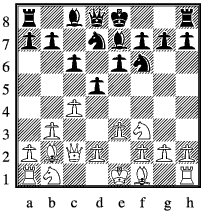
|
| RR v Simon Edwards after 6 ... Nbd7 |
7 Ne5 the position doesn't support this neglecting of the principle not to move the same piece twice in the opening.
7 ... 0-0, 8 f4 Ne4 RR now has a minor panic about he e1h4 diagonal, though a ccol head would reveal nothing to worry about. However on a belt and braces approach, I'll cover h4:
9 Nf3 Bf6, 10 Bxf6 The lack of clarity in RR's thought processes are clear. Nc3 must be OK, ditto Be2, but I'm still needlessly worried about the route to my king via f2, so off the bishops come.
10 ... Qxf6, 11 Nc3 Nxc3, 12 Qxc3 don't like e5 after dxc3
12 ... Qxc3, 13 dxc3 diagram right.
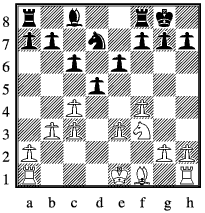
|
| RR v Simon Edwards after 13 dxc3 |
13 ... Re8, 14 0-0-0 a5 Already Simon threatens play both in the centre and on the queenside. Meanwhile RR is responding with what exactly?
15 Bd3 Nb6, 16 Ng5 I want him to play h6 why?
16 ... h6, 17 Nf3 dxc4, 18 Bxc4 Nd5 Simon is probing at the various weaknesses in white's position, doubtless hoping to induce bigger ones. From my side it feels more like teasing - is he coming here or is he coming there? Anyway, one thing I know is that I'm not taking that pesky knight as my e3 pawn would surely become a longterm liability.
19 Rd3 perhaps Kd2 (onto a half open file) isn't so bad, but I resign myself to long term protection of the e-pawn. Except b5 doesn't come.
19 ... Nf6, 20 b4 creating some white squares for the bishop, but seems slow.
20 ... Nd5 Now I can't play my intended retreat of Bb3 as it loses a pawn. Perhaps I should have paid more consideration to axb5 and Bb3, but instead chose
21 b5 Nb6, 22 Nd2 believing that the loss of pawn
22 ... Nxc4, 23 Nxc4 cxb5, 24 Nd6 Rd8 is tolerable as the e-pawn can be advance to cement the knight into position.
22 ... Bd7, 23 a4 cxb5, 24 Bxb5 Red8, 25 Bxd7 Rxd7, 26 Rxd7 Nxd7
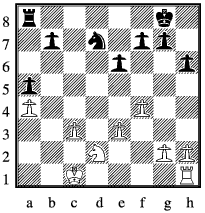
|
| RR v Simon Edwards after 26 ... Nxd7 |
27 Kc2 Rc8, 28 Ra1 Rb1 is the aggressive choice, but today I'm happy with less double edged play.
28 ... Nb6, 29 e4 Kf8, 30 g3 Nd7, 31 c4 A little reluctantly as it allows b4 as an outpost for the knight, but if his kings coming up, so is mine.
31 ... Ke7, 32 Kc3 b6, 33 Nb3 g5 Annoying. If I allow an exchange on f4 I can't stop him penetrating down the g-file.
34 Rf1 I hope my draw offer at this point is not too insulting, though Simon declines anyway.
34 ... Nf6, 35 Nd2 Ng4, 36 h3 Nf6, 37 f5 Rc5, 38 g4 exf5
39 gxf5 Nd7, 40 Kd4 Ne5 Tempus fugit. And when it does, blunders are in the air.
41 Rc1 (of course) Rc7 I thought only I played that sort of move. Hang on, if I take the knight is it mate. All he needs is Rd7 and f6 and I'm cooked. Fortunately however the rules don't permit simultaneous play of these moves, and I have a useful get out of jail card.
We both stopped scoring hereabouts, with well under 5 minutes each left. the final moves were something like:
42 Kxe5 Rd7, 43 f6+ Kd8, 44 Nf3 Rd3, 45 Nd4 Rxh3, 46 Nc6+ (Rd1 would be more powerful)
46 ... Kc7, 47 Ne7 Rf3, 48 c5 g4, 49 Nd5+ Kb7, 50 cxb6 g3
51 Rc7+ Kb7, 52 Rxf7 Ne7 would have set up a pretty mating net.
52 ... h5, 53 Rg7 h4, 54 Nf4 1-0
comment on this article
points = grade of opponent + 100 × your score - 50.
To maintain one's standard one's expected score needs to produce a number of points equal to ones grade, so
your grade = opponents grade + 100 × your expected score - 50
which rearranges to
your expected score = (your grade - opponents grade + 50)/100
or your expected score = (your grade - opponents grade + 50)%
This is of course what you are expected to do 'on average'. In any particular game it may not be possible to obtain the expected score. Further the grading formula only applies when the two players grades are within 40 points of each other. Consequently we cannot expect the expected score calculation to work with bigger grading gaps. All we can say is that the expected score for the stronger player is somewhere between 90% and 100%.
The result can be used to find the par score in a single game, over a number of games, or for a team.
If I outgrade an opponent by 20 ECF points then on average I would expect to score 70% against them. So in a series of five games a typical set of results would be 2 wins for me plus three draws, or 3 wins for me, one for my opponent and one draw.
Playing in a five round congress, if I outgrade my opponents by an average of 20 points (with none differing in grade from me by more than 40 points) I'd expect to score 3½ points (70%). Thus scoring 3/5 would represent a below average return when taking account of the strength of my opponents.
Similarly in a five board match between teams differing in strength by an average of 20 ECF grading points, the par score would be 3½ - 1½ to the stronger team. Leagues run on a handicap basis may use this idea to determine which team wins a match on handicap.
comment on this article
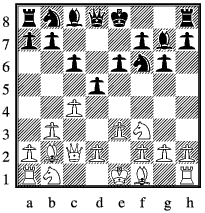
|
| RR v Steve Emmerton after 6 ... Bg7 |
7 ... h5 h6 is usually regarded as the more flexible option, also retaining control over g5, but I can't talk.
8 Be2 Nbd7, 9 Ne5 I plead guilty to simplistic wishful thinking. My plan, if such a name it deserves, is that he castles and I blast open the h-file leading to queen and rook having fun on h7. Amongst the many conditions needed for this to work I need the b1h7 diagonal to remain open, and preferably the a1h8 one too. A simple developing Nc3 would allow e5 and potential closure. Hence Ne5. But if I allow the exchange of the knight then it is not available to support an attack from g5. Does my plan have a future? No. So go elsewhere. 0-0, or d4 or Nc3 all maintain my space advantage and/or lead in development.
9 ... Nxe5, 10 Bxe5 0-0, 11 f4 My opponent and probably several of my other readers will be aware of the West Ham player Martin Peters who was reputed to be years ahead of his time. This is a Martin Peters move. No doubt in the fullness of time a position could be reached when f4 is needed, but that time is a long way away. It is difficult to see what is wrong with either d4 or Nc3, but RR's memory is claiming the official secret's act and refusing to divulge his thinking.
11 ... Ne4, 12 Bxg7 Kxg7 (diagram right>
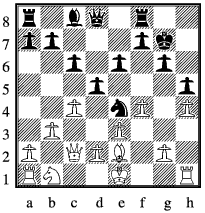
|
| RR v Steve Emmerton after 12 ... Kxg7 |
14 ... d4 Stronger would have been e5 first. eg
14 ... e5, 15 fxe5 d4, 16 exd4 Qxd4 threatening not only the e-pawn but more importantly Qg1+ winning one of the rooks. suddenly the position is wide open. Black's bishop is in the game and his rooks can easily be centralised. Admittedly white doesn't have to take the e5 pawn, but it shows that e5 is not simply a speculative sacrifice.
I'd also had visions of his playing Nf5 to pick up the h-pawn, but I'm happy to castle long and see whether I can continue with my earlier wish to have fun on the h-file.
15 Ne4 Apparently Kf2 is better, though a closer examination of the possible lines starting from the two moves than can easily be done by RR seems needed. Note that
15 Kf2 Nxe2, 16 Nxe2 d3 doesn't win a piece as white has a check with the queen on the long diagonal, a theme that RR is also relying on in some other variations.
15 ... Nxe4 Steve is guilty of the same mis-assessment of the relative merits of the minor pieces as RR. There is also a nasty tactical blow to taking the bishop in that
15 ... Nxe2, 16 Kxe2 e5 with threat of d3+ and Bg4+ winning the queen. Even if RR sees the threat his response wil give black the time to open the centre, which with so many line pieces still on the board will not be a healthy place for the white king to reside.
16 Qxe4 dxe3, 17 Qxe3 Qf6
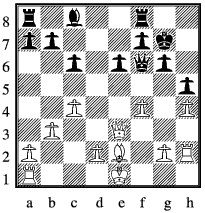
|
| RR v Steve Emmerton after 17 ... Qf6 |
18 Qe5 Rd8 19 g4 Despite his recent difficulties in the game, RR hasn't had his aggression beaten out of him. g3 would have been more solid.
19 ... Qxe5, 20 fxe5 hxg4, 21 Bxg4 Rd4, 22 Bf3 Bd7, 23 c5 Part of the plan to restrict his bishop, but in truth black isn't going to be playing c5 to create squares for his bishop any time soon. Another mistimed or redundant move. Better would have been an immediate Ke2 with threats to embarrass his rook.
23 ... Rh8, 24 h5 gxh5, 25 Ke2 Rf4= An easy draw offer to turn down as I still believe I have the superior bishop, whilst his material advantage isn't going to last.
26 Rg1+ Kf8, 27 Ke3 Rb4 diagram right
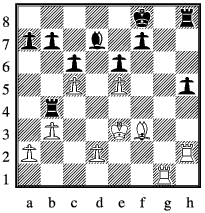
|
| RR v Steve Emmerton after 27 ... Rb4 |
28 Bxh5 a5, 29 d4 a4, 30 bxa4 Rxa4, 31 Rb1 Ra7 Steve elects to have no active pieces. In truth I don't see the available check being that much use to him either, but this passivity cannot be good.
32 Rb3 Another less than brilliant choice. Freeing the bishop should be the focus of my attention, so Rbb2 or Rbh1. Fortunately Steve is also playing a slow defence to my slow attack.
32 ... Ke7 f5 or f6 here would have solved the problem of his bishop. I'd need to play Rbb2 to save losing the exchange to the Be8 follow-up.
33 Ke4 f5+, 34 exf6+ Kxf6, 35 Rf2+ Ke7, 36 Rf7+ Kd8
37 Bg4 Ke8, 38 Rg7 Rf8 I'm planning to penetrate with my king, but I now have a feeling this will end badly for him without that happening.
39 Ke5 Rf7, 40 Bh5 1-0
A win in the end, which I am confident would have been obtained without the final blunder, but RR's choices hardly made it a sober and compelling display.
comment on this article
The better understood of its two purposes is to indirectly limit the strength of the individual players in a team. Let's consider its effect on division teams where the overall limit of 460 is subject to a minimum counting grade of 90. To fit a player with as high a grade as possible in the team, the other three would be at the minimum counting grade. Thus highest possible grade is
460 - 3 × 90 = 460 - 270 = 190.
Not a very tight cap, but this allows clubs with a single strong player to field a team in a division appropriate for the rest of the team.
To get a second high graded player in the team, then putting the other two at the minimum counting grade means that the top two players have a total grade of
460 - 2 × 90 = 280 so we could fit a second strongest player in at 140 if the strongest player is also of that grade. A tighter cap.
On to the third highest graded player. Now there is only one player who could be at the minimum counting grade, leaving 370 points for the other three. The third highest graded player will be as highly graded as possible if the three players all have the same grade of 123 and a bit. It is interesting to note that those teams so strongly supporting an individual cap in division five that they were willing to go along with a proposal to remove the minimum counting grade there have created a situation where it would be possible to have a team deemed legal in division five, but overgraded on division four because the third board was too strong.
The caps for the various boards in divisions in which a minimum counting grade applies are given in the table below, with values rounded down to the nearest whole number. The last row gives the values for division 5 before the removal of the minimum counting grade, and the last column the minimum counting grade. Do be careful when interpreting the table. In order for a particular player to have a grade as given, all the lower graded players in the team must be at the minimum counting grade, whilst all the higher graded ones will in fact need to have the same grade as the player you are interested in (after allowing for rounding), which is why the value for the last player is the average limit for the team. Thus in division three you cannot fit together players 205, 155, 138 and 120. You can have two at 155 with the other two at 105.
| division | highest grade | 2nd highest | 3rd highest | 4th highest | 5th highest | MCC |
| 2 | 245 | 182 | 161 | 151 | 145 | 120 |
| 3 | 205 | 155 | 138 | 120 | 105 | |
| 4 | 190 | 140 | 123 | 115 | 90 | |
| 5 | 175 | 125 | 108 | 100 | 75 |
Done that? Read on.
Here are two I've produced, one containing a single strong player, and the other with a smaller spread of ability:
Team A: 175, 130, 110, 105
Team B: 145, 135, 125, 115
Now lets have an imaginary match between them, making use of the expected scores as discussed under the article "How well should one do?" a few days ago:
| board | team A | res | res | team B |
| 1 | 175 | 0.80 | 0.20 | 145 |
| 2 | 130 | 0.45 | 0.55 | 135 |
| 3 | 110 | 0.35 | 0.65 | 125 |
| 4 | 105 | 0.40 | 0.60 | 115 |
| total | 2.00 | 2.00 |
The expected result between my two teams is a draw. If you play imaginary matches between your team and mine, what expected results do you get? In my example none of the boards had players whose grades differed by more than 40 points. If in your match-ups there are such boards then the expected result will be somewhere between 0.9 and 1 for the stronger player. However if there are no such boards you will find the expected match score is a draw.
Now I shall introduce my C team, who are rather lop-sided, having players garded 205, 105, 105, 105, and play them off against my B team:
| board | team C | res | res | team B |
| 1 | 205 | 1.00 | 0.00 | 145 |
| 2 | 105 | 0.20 | 0.80 | 135 |
| 3 | 105 | 0.30 | 0.70 | 125 |
| 4 | 105 | 0.40 | 0.60 | 115 |
| total | 1.90 | 2.10 |
Now the match result is no longer expected to be a draw; the team with the very strong player will now on average lose even if we assume the top board is bound to win. In practice a club is unlikely to have three players graded exactly 105, so some of their lower boards will be weaker than the minimum counting grade so the expected deficit will be greater. Fielding a single very strong player will on average result in poorer results.
If fielding a single very strong player weakens a team, does that mean that fielding a single very weak player strengthens it? With the minimum counting grade in place, the answer is no (assuming of course that that is indeed the grade of the weakest player). A D team of 139, 138, 138, 105 has players within 40 points of their opposite numbers in the A and B teams, so expected result is a draw.
But now remove the minimum counting grade, which effectively means set it to zero. How might an E team of 174, 173, 173, 0 do against the B team? Here goes:
| board | team E | res | res | team B |
| 1 | 174 | 0.79 | 0.21 | 145 |
| 2 | 173 | 0.88 | 0.12 | 135 |
| 3 | 173 | 0.98 | 0.02 | 125 |
| 4 | 0 | 0.00 | 1.00 | 115 |
| total | 2.65 | 1.35 |
The E team do well by forcing the opposition to waste strength beating a new born babe, next door neighbours cat or David Fault. Without a minimum counting grade in place teams can improve their chances by fielding lop-sided teams with one very weak (or non-existent) player. In division two, they could go further and field two such players. Which second division matches would a team consisting of players graded 245, 240, 240, 0, 0 not win 3 - 2?
Thus the second task of the minimum counting grade is to prevent teams from increasing their chances by fielding a very weak player to free up space for several relatively strong ones.
comment on this article
Round one, white against Robert Wilby, and for once Fritz believes RR has played the opening with a reasonable degree of sanity.
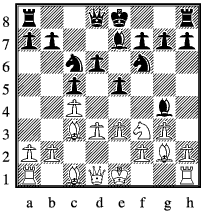
|
| RR v Robert Wilby after 7 ... Bg4 |
12 Nh4 exd3, 13 Nxg6 hxg6, 14 Nf4 Strongly tempted to take on e7 first to have an unchallenged bishop pair on an open board. But I also like the idea of leaving his bishop on to become a piece of less than great beauty.
14 ... Qb6, 15 Qxb6 don't mind if I do
15 ... axb6, 16 Nxd3 Na5, 17 b3 Ra8
I can win a pawn here with Bxa5 and Bxb7, but see no need to hurry. I'm going to have bishops on both long diagonals and a backward d-pawn for a target. This must be winning without the material grab.
18 0-0 Ra7, 19 Bc3 0-0, 20 Nb2 Rfa8, 21 Rxa5 He was threatening Nxb3. Of course could have neutralised the threat by moving the rook away from a1, but I'm up for a game of "my bishop's better than yours".
21 ... bxa5, 22 Rad1 Ne8, 23 Na4 Bd8 Bf6 would have denied my knight the use of c3, but allowed Nb6, a4 and Nd5, again killing play on the a-file.
27 Rd3 Ke7, 28 Rfd1 Bc7, 29 h4 Rb6, 30 e4 Rd8, 31 f4 f6
33 exf5 gxf5, 34 Re1+ Kd7, 35 Rde3 Doubling up against the knight. If the knight moves Re7+ wins the bishop, else Re7+ wins the knight. Black gives up the exchange to put a stop to thes threats, but unsurprisingly the sacrifice fails to create a route to freedom.
44 ... Rxg7, 45 Rc6+ Kb7, 46 Rxc5 Rd7, 47 Rd5 Re7
Took my time, but got there in the end.
Regular readers will know that I use a silicon friend to look at the game to try to make sure I don't make comments that are too daft in relation to the position. I'm in the process of switching allegiance from Fritz 9 to Stockfish 4, and I find it interesting that in the position shown Fritz has white +0.6, whereas Stockfish says +0.8. My gut reaction is that I haven't played the opening as badly as Stockfish says, but what do I know? There was a position in the recent world championships which I was watching on Chess Bomb which the resident analyst (Houdini) scored as -0.66, but Fritz scored +0.33. Interesting, I thought. Two progs both far too strong for me, with a pawn difference in their assessments. So I tried Stockfish, and he too said -0.66.
7 c4 Nc7 I have conveniently forgotten why I chose not to play Nf6
18 Bd6 Diagram right.
18 ... Nf4, 19 c5 Nxe2+, 20 Rxe2 Bg4, 21 h3 Bxf3, 22 gxf3 Nd4
24 f4 Nf5, 25 Ra3 a6, 26 fxe5 Rxe5, 27 Rad3 Re2
18 Ne2 Bf6 I see, vacating f6 for the bishop.
19 Ne5 Nf4 Bg4, 20 Rdg1 'I dare you to take the knight' is better
19 ... Nxe5, 20 dxe5 Be7, 21 Nf4 c5
22 h5 g5, 23 Nxe6+ fxe6, 24 Bg6 Qc6, 25 Ba3 Rc7
27 Bxe7 Rxe7, 28 f4 cxb3, 29 Qxb3 axb3 must be better, keeping the knight out of c4, but at least I didn't take the queen (he can take on a2 with check before recapturing, thereby winning a pawn and having connected passed pawns to shove down my throat).
29 ... Qa4, 30 Rc1 Qxb3+, 31 axb3 a5, 32 Rc5 I'm beginning to feel in control again.
32 ... a4, 33 Rb5 Nc8, 34 bxa4 b6, 35 Rc1 Ra7= Does he believe this is drawn or is this simply a typical junior "Have you noticed you're winning?" draw offer?
36 Rc6 Re7 If his e-pawn goes I'll be threatening both his d-pawn and an advance of my f-pawn.
37 Rb4 Maybe not best, but now he's all tied up there is no hurry.
So to record a win, RR had to win twice. A feeling with which I suspect some of my readers may be familiar. But at least the second chance to win came.
13 Rd1 Qa5, 14 Bc1 Qh5, 15 h3 Nbd7, 16 0-0 Rad8
22 Qxe4 Nf6, 23 Qc2 Re7, 24 Bb2 Red7, 25 Qe2 Ne8 (not liking the knight on f6 if the d-pawn advances)
30 Rc2
33 fxe3 Nxe3, 34 Rc1 Bf4, 35 Rf2
35 ... Nd5, 36 cxd5 bxc1, 37 Bxc1 Rxd5 which I reckon is pretty well all square. There followed considerable manoeuvring in an attempt to gain advantage.
38 Nf3 Re8, 39 Kf1 Kf8, 40 Re2 Ra8, 41 Bd2 f6
46 Kd2 Re8, 47 Kd3 Kg6, 48 Rf2 f5, 49 Nd2 h4
10 ... e5, 11 Be2 b5, 12 0-0 bxc4, 13 bxc4 Rb8 This seems a pretty natural move to me, but Stockfish tells me it is a mistake - a5 should be played first. Clearly a5 keeps my knight out of b4, but I'm not playing it there anyway am I? Don't want to lose a pawn and leave his a-pawn passed. Closer examination shows that this is another flawed calculation by RR. The c6 knight needs to guard the e5 pawn whilst
14 Qc2 Bf5, 15 Nd2 still blind to the availability of Nb4
15 ... Bd6 diagram right
16 g3 Bh3, 17 Rfe1 Re8, 18 Bf3 Qc7, 19 Rab1 Bf5 So what have I achieved so far? Blocked of the centre and substantially reduced the chances of a kingside assault. But that still leaves the queenside, where my defences against b-file penetration or attack on the a-pawn are somewhat short of strong. No surprise that this is where Ray now starts playing
28 Rb1 Nc5, 29 Rxb8 Qxb8, 30 Nb4 a5, 31 Nd5 Qb3
33 ... f6, 34 Kf2 Kf7, 35 Bxd6 Nxd6, 36 Ke2 Nb7
Escaping with half-a-point is perhaps payback for my earlier struggles. Pleased with an unbeaten weekend, but not perhaps with how it was achieved.
10 ... Nxe5, 11 Bxe5 Qb6, 12 Qb2 Qd8, 13 0-0 Rf8
14 ... Ne8, 15 Bxg7 Nxg7, 16 Nf3 dxc4, 17 dxc4 Qc7
22 ... Kh8, 23 Rh3 definitely wrong
25 ... Rad8, 26 Rd5 Kg8, 27 Rfe8 Qd2 Too clever. Rhd3 was needed to maintain the advantage. I'm trying to threaten Qh6, but it is never strong enough:
28 ... h5 (Rxd5, 29 exd5 Qxe5 is stronger)
29 Rh4 Really must stop trying to justify earlier errors. It leads to trouble. Accept the loss in the centre and play Bd7.
29 ... Rxd5, 30 cxd5 Qxe5, 31 Bd7 Rd8, 32 Bc6 Ne6
33 g4 My frazzled one-track mind couldn't come up with any better ideas than this. Perhaps I should try g3 to keep the knight out of f4 and hope he chooses to take queens off with Qd4+. At least that would level the game.
33 ... Qxe4, 34 Qf2 Nf4, 35 gxh5 Fatuous. Do I have a reply to g5? OK, I can swap off into a bishop against rook ending, but chances of holding that look remote.
35 ... Qb1+, 36 Qf1 Qxf1+, 37 Kxf1 Nxh5 Somehow I've emerged just a pawn down. But he has two passed pawns to my one, and the knight traditionally works better with the rook than does a bishop. Lots of work still to do if I'm to avoid a blob.
38 Ke2 Nf6, 39 Ra4 Nxd5 It's that knight again. Suspect that objectively its best to swap the exchange the minor pieces, but tend to feel there is more chance of his going wrong if I keep them on. Maybe later I can sac my bishop for his last extra pawn and leave him with R+N v R.
40 Rxa7 Nb4
42 Kd3 Nb4+, 43 Kc3 Nd5+, 44 Kb2 Nf6, 45 Bc6 Rd2+
49 Bxd5 Rxd5, 50 Rc6 Rd1, 51 b6 Rb1, 52 Kc4 Kg7
54 Kd6 Rb1, 55 Kc7 f5, 56 b7 Rxb7, 57 Kxb7 Kh6
That's one that got away for both of us. By the end we were the last board in play with the score standing at 3½ each. Just as well it came back to me.
But I get ahead of myself. Stafford A away in the league, and another meeting for RR with Stephane Pedder.
5 Nf3 0-0, 6 e3 b6, 7 Bd3 Bb7, 8 Nbd2 Qc7 Seems natural to post another piece looking towards his kingside. I remember a player torturing the English language when commenting on his game by saying that he was going to diagonalise his opponent. At the moment I'm thinking of giving Stephane a thorough diagonalising if he gives me half a chance.
9 b3 probably doesn't wish to encourage my bishop onto d6 exerting more pressure on h2.
13 ... Qb8, 14 Ng5 (diagram left)
14 ... h6, 15 Ngf3 e5 with threat of e4 and a fork
16 Nh4 had expected Bf5. Now not merely comfortable with my position, but actively enjoying it. Shoving pawns is always fun.
16 ... d4, 17 Nf5 e4, 18 Bb1 d3, 19 Qd1 Without having a mating attack or being material up this (position right) is surely as good as it gets. OK, he has some play with moves such as b4, Ba2, Qb3, c5 in some order, but I must be able to train my artillery on his king more quickly.
23 Nb3 h5, 24 Re1 h4, 25 Nf1 h3, 26 Nfd2 hxd2
Didn't see that this line could continue
More to the point I didn't spot that he couldn't simply ignore the original capture as
31 ... Ne5, 32 Nd4 Rxd4 This exchange sac is easy to play as the recapture will free the advance of my e-pawn and allow my b7 bishop into the attack.
33 exd4 e3, 34 fxe3
34 ... Bxh1, 35 Kxh1 Nef3, 36 Nxf3 Qg3, 37 Nxh4 Qxh3+
39 Qf3 Qg5+ (Re4 still winning), 40 Kf2 Re6
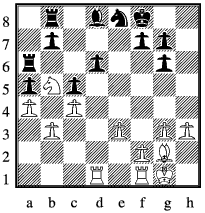
RR v Robert Wilby after 26 ... Kf8
Whilst the route to a breakthrough may not be clear, I have a stranglehold on d5 with the d6 pawn a target. This is almost playing chess by numbers - double rooks on the d-file.
32 Kf2 f5 Black's patience runs out, but white can take as much time as he wants anyway.
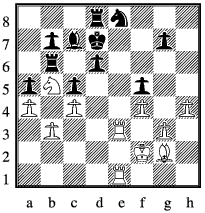
RR v Robert Wilby after 35 Rde3
35 ... Rxb5, 36 axb5 Nf6, 37 Re7+ Kc8, 38 Rxg7 d5
39 Ree7 Bd6, 40 Rxb7 Ne4+, 41 Bxe4 dxe4, 42 Rb6 Rd7
43 Rc6+ Rc7, 44 Rxd6 It wouldn't be a fully refledged RR game without an atrocity somewhere, though this idiotic surrender of the exchange only serves to prolong the game a little. The pragmatic choice would have been to remove all the pieces and ask the black king to stop both the b and h pawns from queening. Don't think it would succeed.
48 Rxf5 Rc7, 49 h5 a4, 50 bxa4 Rxc4, 51 a5 Rc2+
52 Ke3 Rc3+, 53 Kxe4 Rxg3, 54 h6 1-0
comment on this article
Sat 16th: Cowardice
Round 2, and black against Dave Cordner, one of the leading seeds in the section. We join the game with Dave contemplating his next move after castling.
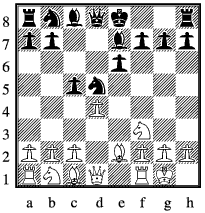
Dave Cordner v RR after 6 ... Be7
rnbqk2r/pp2bppp/4p3/2pn4/3P4/5N2/PPP1BPPP/RNBQ1RK1 w
Onto the game. I'd take on c5 and then play c4, but my silicon friend (both personalities) says nothing to choose between the move orders. Anyway Dave played c4 first.
8 dxc5 Qxd1, 9 Rxd1 Bxc5, 10 Nc3 f6, 11 Ne4 Be7, 12 Be3 0-0
13 Nd6 Bxd6, 14 Rxd6 e5, 15 Rad1 Nc6, 16 Bc5 Re8, 17 R6d2 Ne6 A move late perhaps. On the previous move it would have offered an exchange of material. Now white can cement his bishop into d6, though I don't think it can cause as much trouble as a knight there.
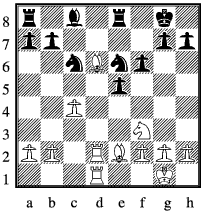
Dave Cordner v RR after 18 Bd6
I have to confess that I felt under considerable pressure during the last dozen moves as I sought to unwrap my position without dropping material or conceding weaknesses. Now I can activate my minor pieces, and will surely soon own d4.
23 Re3 Rad8 Although I now feel very comfortable I confess to not having any great ideas as to how to push on.
28 Bc7 Rxd3, 29 Rxd3 Rxb2, 30 Rd5
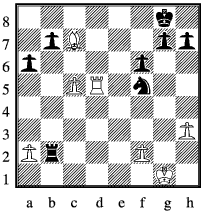
Dave Cordner v RR after 30 Rd5
A lot of time has been spent by both players. (I seem to use much more time than I did only a couple of years ago - whether this is better time management or brain refusing to operate properly is an open question). Black has several advantages - an extra pawn, 2 pawn islands against 4, and a knight which traditionally works better with a rook than does a bishop. Despite this I'm worried, almost certainly unnecessarily, about Bb6, death of my b-pawn and having to give up a piece to stop his c-pawn queening. Consequently I simply played Rb1+ and offered a draw, which was accepted.
comment on this article
Sat 16th: Winning Twice
Saturday afternoon, and I'm faced by a young man by the name of Owen Bennett. You'll gather from the title that this game did not follow a single smooth plan. An early pretend kingside attack by RR had led black to react to produce the slightly unusual pawn structure shown. On the other hand white's king will not be able to cower behind a neat row of three pawns whichever side he castles. It is not obvious to me which, if either side has an advantage.
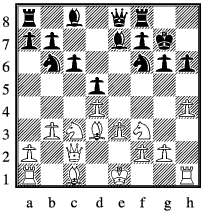
RR v Owen Bennett after 14 ... Kh8-g7
r1b1qr2/pp2bpk1/1np2npp/3p4/3P3P/1PNBPN2/P1Q2PP1/R1B1K2R w
15 Bb2 Be6, 16 0-0-0 Rc8, 17 Kb1 Nfd7 White's queenside castling would normally lead to an assault by the black a-pawn, so the earlier Rc8 was slightly unexpected despite placing the rook on the same file as white queen and king. I don't believe he is going to (or should) play f5, and c5 if he wishes can be played without this knight move. Difficult not to conclude that this knight retreat is a bit of a timewaster. My queens knight though has useful squares on the kingside to move towards.
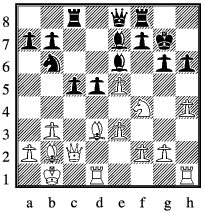
RR v Owen Bennett after 21 ... c5
Now Bxg6 and RR is well on top as a black recapture allows Nxe6+ so that white is pawn, exchange and attack up. Failure to recapture leaves white at least a pawn and attack up, with the bishop still in play to support said attack. But RR was fixated with the h-pawn, so
26 g3 c4 My 'win' has gone, and am under attack down the c-file. Not that there is any great oopmh behind his attack.
37 ... Rd8, 38 Kb2 Rf8, 39 Bd3 1-0
Black has run out of things to do, and the threat of Ba6 means the b-pawn is on it's deathbed. Mopping up operations to follow.
comment on this article
Sun 17th: Winning Once
Having squeaked past Oewn Bennett in round three, RR found himself black against older brother Rhys in round four. We join the game with RR having just castled.
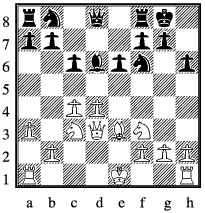
Rhys Bennett v RR after 12 ... 0-0
rn1q1rk1/pp3pp1/2pbpn1p/8/2PP4/P1NQBN2/1P3PPP/R3K2R w
The position may look fairly familiar to many who will have seen similar as both white and black, with white hoping to open the centre to his advantage. But not yet:
13 d5 cxd5, 14 cxd5 exd5, 15 Nxd5 Nxd5, 16 Qxd5 Bb4 has a 0-1 feel about it, so white would have to abort part way through.
17 b4 Bc7, 18 Qc2 Nb6, 19 Qe2 Rfe8, 20 Rfe1 Nbd7
21 Ne4 Nxe4 My position is the more cramped, so happy to exchange material.
26 Qc2 a6, 27 Re4 Nd6, 28 Re2 Qf5, 29 Qxf5 Nxf5 Whether or not it is the correct one, my basic plan has been to try to exchange pieces without allowing the d-pawn to advance to good effect. The hoped for result is that the d-pawn becomes weaker with the exchanges.
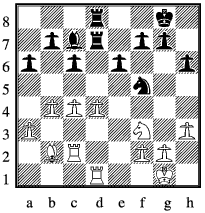
Rhys Bennett v RR after 30 Rc2
Perhaps Rhys hopes that the bishop will become a target if he advances the d-pawn, but I'm now in a position to change plan and make my own advances:
30 ... e5, 31 Rcd2 e4, 32 Nh2 e3 Bf4 first would have been stronger, but although I thought of it I failed to follow through.
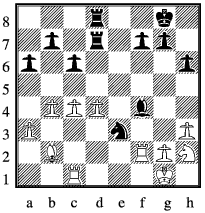
Rhys Bennett v RR after 35 Rf2
Definitely like my position, but now what? Had planned
35 ... Nxg2 but became unaccountably worried about
36 Rxg2 Bxc1, 37 Bxc1 Rxd4, 38 Bxh6 not thinking straight enough to see that I can then simply play Kh7 and pick up the c-pawn. My rooks would dominate.
Didn't even see 35 ... Rg4 - too busy trying to think tactically to spot such quiet but useful moves. Instead I found the less than successful
42 Bc3 Kf7, 43 Ke1 h5, 44 Nd2 g5, 45 Ne4 b6 By now his knight is looking the best piece on the board and I have genuine fears of dropping a pawn.
50 Nc4 b5, 51 Ne3 Rd7, 52 Nc2 taking the f-pawn with either rook or knight is not advised
52 ... Re4 (guess f4 better)
53 Ne3 Re8, 54 Bd2 Kf5 and a flurry of moves later with both players very short of time a draw was agreed. No second chance to win this; indeed the draw may be fortuitous.
comment on this article
Sun 17th: Never Winning
Final round, and after my previous efforts I'm not sure whether to pleased that I'm unbeaten, or disappointed with the heavy weather I've made of the games so far. I'm certainly not pleased to be playing Ray Gamble in this round though as my previous two games have been one draw and one loss, with ne'er a sniff of victory. We join the game after a mere half-dozen moves in a position similar to ones RR has had many times before. My normal inclination is to exchange on d5 and then play d4, but have a totally unnecessary panic about athe black knight coming into e4 with my c3 knight pinned on the e1a5 diagonal. Talk about not thinking straight. The result of this panic is the equivalent of an own-goal. Ray has the lead. Can I equalize?

RR v Ray Gamble after 6 ... c5
rnbq1rk1/pp2bppp/4pn2/2pp4/2P5/1PN1PN2/PB1P1PPP/R2QKB1R w
7 d3 Nc6, 8 a3 d4, 9 exd4 cxd4, 10 Na2 Hardly best, but still in panic mode. Ne2 followed by Ng3 must be better.
14 Nb4 Bxb4, 15 axb4 Rxb4, 16 Ba3 and white is picking up the exchange.
Simple when you look in the right direction. However RR thinks he can't play Nb4, so the game continues:

RR v Ray Gamble after 15 ... Bd6
With most of my army cowering on the second rank, I'm still in glass half-empty mode. I can see all sorts of attacks both on h2 and in the centre coming. Moves like Re8, Qc7, e4 wouldn't be designed to make me sleep easy at night. Or maybe the queen will suddenly appear on h4. So I'll cut the route to h2 at the expense of creating holes around my king.
20 Bc1 Rxb1, 21 Qxb1 Rb8, 22 Qc2 Nd8, 23 Bg2 Ne6
24 f3 Nc5, 25 Ne4 Bxe4, 26 fxe4

RR v Ray Gamble after 26 fxe4
26 ... Nb3, 27 Bg5 Ne8 I think Ray should probably have grabbed the a-pawn whilst he could, and not worry about my disrupting his pawns with Bxf6. Now for the first time since we joined the game I'm beginning to feel comfortable.
32 Qxb3 Nxb3, 33 Be7 holding the a-pawn. The rest is shadow boxing.
37 Kd1 Ke6, 38 Kc2 N3c5, 39 Bh3+ Kd6, 40 Bc8 Nd8
41 Bg4 Nc6, 42 Bd1 Nd8, 43 Kd2 Nc6, 44 Nb6 He who is never wrong tells me this is a mistake which black can take advantage of with f5 and e4. I'll believe him.
44 ... Nd8, 4 Nd5 ½- ½.
comment on this article
Tue 19th: Death of a Super-Hero
Back to league action, and a visit to Alsager in the Open Cup.
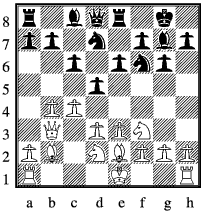
RR v Brian Birchall after 9 ... Re8
r1bqr1k1/pp1n1pbp/2p1pnp1/3p4/1PP5/1Q1PPN2/PB1NBPPP/R3K2R w
10 Ne5 Do I seriously believe I'll be allowed to move the other knight to f3 in suppost before this one dies? No. Is swapping knights part of some master plan? No. So why not do something more useful like Rc1 or 0-0? Answers on a postcard please.
14 f4 I'm attacking. Must be in glass half-full mode today.
18 Rad1 c5, 19 b5 b6, 20 Ne5 Nf5, 21 Ng4 Ng7, 22 Rf3 Too optimistic. Nf6+ must be better. But I'm still on the front foot.
23 ... e5, 24 fxe5 Bxg4, 25 Bxg4
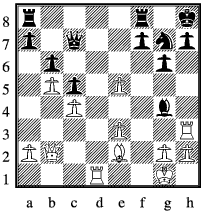
RR v Brian Birchall after 25 Bxg4
OK. I'm a pawn up, but it's a fairly lousy one. Rather still have my knight and my attack. But this is what I've got, so let's see what I can make of it.
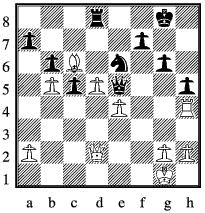
RR v Brian Birchall after 32 ... Ne6
This is horrible. I'm sure I was winning this. Now that knight that has spent half the game single handedly defending his king is coming to molest mine.
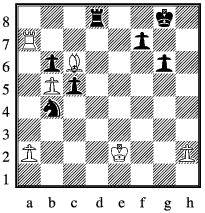
RR v Brian Birchall after 40 ... Nb4
Seriously considered Ra6 here (left) as I'm not sure he'd enjoy the aftermath of taking it or my bishop, but my courage failed, so instead:
41 Bd7 Nxa2 That's three pawns the knight has gobbled in the ending. Its beginning to annoy me. Defending its king. Attacking mine. Gobbling pawns. Is there anything this knight can't do?
46 Kc3 Rxh2, 47 Rb7 Rh5, 48 Rxb6 Nd5+ The fork forces me to remove the heroic knight from the board.
53 Kxc5 Rc1+ Unlike the knight check I didn't take earlier, but should have done, this is one that shouldn't be taken as it helps my king advance. Sooner or later black will need to take the b-pawn. He needs to get his own pawns sufficiently advanced that they represent a serious counter-threat.
58 Kb6 Kh5, 59 Kc5 g5, 60 Kd4 f4, 61 Ke4 Kg4
62 Rf6 Kg3, 63 Rf8 Kg4, 64 Rf5 Kh4, 65 Kf3 Kh5
66 Rf8 Kg6, 67 Kg4 1-0
comment on this article
Wed 27th: Censored
Some missed opportunities hurt more than others. Todays was a real head-banging affair; my teammates were probably pleased I didn't have a cricket bat to fling around the dressing room.
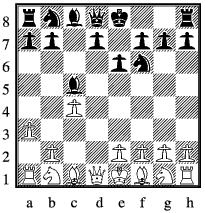
Stephane Pedder v RR after 4 ... Bxc5
rnbqk2r/pp1p1ppp/4pn2/2b5/2P5/P7/1P2PPPP/RNBQKBNR w
We join the game early after an exchange of pawns on c5. RR's games with Stephane seem to get tactical pretty quickly, so I can anticipate having to start calculating early on, even though I know that it will end up being mentally exhausting. Indeed Stephane is thinking already, so I best join in. If he plays b4 do I reply Bxf2+? What do you think? Anyway b4 didn't come at this point.
9 ... d5, 10 Bb2 Nbd7, 11 0-0 Rad8, 12 Qe2 Rfe8
13 Rac1 Interestingly Stockfish suggests we would both have been better to have initiated the exchange of c4 and d5 pawns on our previous moves. I can't say it is immediately apparent why this is superior to getting all our pieces into the game. But then I'm not even close to being on the route to becoming a titled player.
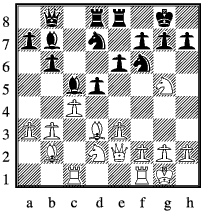
Stephane Pedder v RR after 14 Ng5
The actions we take are greatly influenced by our assessment of the position. prior to Stephane's latest move my silicon friend has him ahead by the equivalent of a pawn, yet I can rarely remember having felt so comfortable in what apparently is a poor position. I'm fully developed and have things to do, whether in the centre or diagonally towards his king. Same as Stephane as far as my limited ability to assess goes. Perhaps it is a case of it being his move gives him a potentially lasting initiative. Anyway, he has used that move to home in on h6. Is there a real threat there or is he just hoping to disrupt the pawns in front as the beginning of a softening up of my kingside defences? Ignore or play h6 or g6? Think I'll go for h6 - then he can't sac on h7.
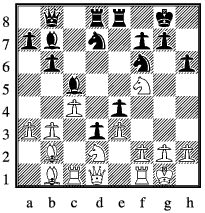
Stephane Pedder v RR after 19 Qd1
19 ... Ne5 taking time out to play a5 is superior
20 b4 Bf8 Again not best. Nge4 would have required a decision on how best to defend the assault on h2.
21 Ba2 g6, 22 Ng3 Bg7 Slow. The f6 knight is not in need of defence, so shoving the h-pawn must be good. Fortunately Stephane seems to be more interested in organising a defence rather than initiating counter play with c5. Either that or he is intending jump out from behind those central pawns in a single irresistable surge.
27 Kxg2 Nf3, 28 Rh1 Ng4, 29 Bxg7 Kxg7, 30 h3 Nh4+
31 Kg1 (diagram left)
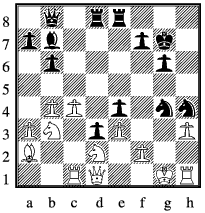
Stephane Pedder v RR after 31 Kg1
The difference between a puzzle and a game is that in a puzzle you know there is an answer. Although my commentary has been sparse my brain has been working flat out for some time trying to make sure (not always successfully) that I leave no way for Stephane to ease the pressure. I can see
31 ... Nxe3, 32 fxe3 Qg3+, 33 Kf1 Qg2+, 34 Ke1 and I can pick up the rook and a couple of pawns for the knight I gave up.
34 ... Nf3+, 35 Nxf3 exf3 with multiple mating threats.
31 ... Nxe3, 32 Qe1 Nhg2 leaves his queen feeling distinctly ill. So my knight ran away:
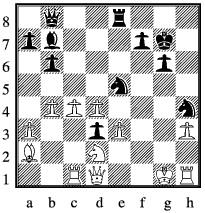
Stephane Pedder v RR after 34 fxe3
How to deliver the killer blow? Thinking of Qg3+ and Qg2+, but of course my knight is in the way. So perhaps Nxc4 first. Sometimes the brain just refuses to co-operate. Nef3+ dismissed because I can't decide what recapture to make if he takes it. The Qg3+ idea just isn't processed by my grey cells in this line. It gets worse. having looked at the position for some time I come to the conclusion that regaining the exchange is best. Can someone give me a new brain please, this ones broken.
38 Kg1 Qxh4 I'm still in panic mode about misplaying the attack earlier (and the sands of time running out). My gut reaction had been Qxe3+ here, but couldn't spend enough time to calculate whether in subsequent checks he could block with his knight. He can't, and my rook could join in the fun with his pieces mainly spectators.
41 Rg1 Qh4+, 42 Qg3 Rf6+, 43 Ke1 Qh5, 44 Qg4 d2+
45 Kxd2 Qh2+, 46 Rg2 Qh1, 47 Rg1 Rf2+, 48 Kd3 1-0
I'd been playing on increments for some time (not the position for that!) and my flag finally fell. How can I not find the wins when the position is so huge? Find me a wall to bash my head on. And the worse thing is that failing to win meant the team failed to draw. Boo-hoo.
comment on this article